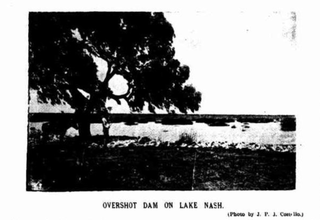Millungera Station is a pastoral lease that operates as a cattle station in Queensland, Australia.
Millungera Station is a pastoral lease that operates as a cattle station in Queensland, Australia.
It is located about 144 kilometres (89 mi) north east of Cloncurry and 197 kilometres (122 mi) south of Croydon in Queensland.
The station occupies an area of approximately one million acres, 1,562 square miles (4,046 km2), and is the primary breeding ground for the Acton Land and Cattle Company, which is able to stock 40,000 head of cattle. [1] The property has at least one outstation, Crowfels, which has a Santa Gertrudis stud. [2] The station is situated in the Queensland Gulf country a generally flat tropical savannah with plains of mitchell grass. The property has some frontage along the Flinders River and is close to the Saxby River.
The station was established in 1864 along with nearby Taldora Station by the pioneer James Gibson in 1864. Gibson had also established the first property along the Flinders River, Prairie, in 1861. [3]
In 1880 the property was still owned by James Gibson and Company. The Melbourne Queensland Pastoral Company was set up with capital of £120,000 to purchase both Millungera and Taldora Station which had a combined area of 937,600 acres along with 20,000 head of cattle for £80,000 leaving plenty of capital left for further development, the property had been inspected by William Meredith who was to manage the station. [4]
Meredith died in 1881 with his share of the station and stock being passed onto Salome Meredith of Brisbane. [5]
In 1886 Millungera was owned by Meredith, Menzies and C. and the property was being managed by Mr Nutting. The homestead had been built by this stage and was described by a visitor as "the home station house a good one, built at great expense with a 12 foot verandah all around, good kitchen and stores and outbuildings with a permanent hole of water close by". Meredth's grave was also located just a short distance from the homestead. [6]
A total area of 176,400 acres (714 km2) was resumed from Millungera early in 1907 which was cut into eight separate properties in the hope of attracting immigrants to the area. [7] Large tracts of grazing country at the station were burnt out by bushfires later the same year, other properties surrounding Millungera were similarly affected. [8]
While some of the surrounding districts were struck by drought in 1928, Millungera was inundated by 15 inches (381 mm) of rain in 24 hours. [9]
The herds at Millungera and surrounding properties affected by the condition known as pegleg in 1929. This condition is a phosphate deficiency and it was recommended that the cattle were provided with Nauru phosphate salts.
The station was put up for auction along with all the plant, improvements and 24,800 head of cattle in 1930. All of the pastoral holdings separate leases were listed in the sale, Millungera 735 square miles (1,904 km2), Tharwan 383 square miles (992 km2), Savannah Downs 354 square miles (917 km2), Kuradin 293 square miles (759 km2), East Creek 168 square miles (435 km2) and other smaller leases. [10] The holding, with a total area of 2,171 square miles (5,623 km2), was passed in with no bids. [11]
In 1933 an experiment was conducted to introduce Zebu cattle into the herd to make the English bred stock would give them resistance to tropical diseases and cope better with the tropical conditions. The station was still owned by Meredith Menzies Pty Ltd at this time. [12]
In 1950 a stockman, Alan Doyle, went missing in the heavily timbered Savannah portion of the holding prompting a search party to be sent out. Doyle was the third person that had gone missing at Millungera in a period of five weeks. [13] Doyle was found a week later after feeding himself on boiled grass and goanna. [14]
CSR Limited auctioned off the property, which the Actons bought for A$7 million in 1985 with its 26,000 head of cattle. [15]

Wave Hill Station, most commonly referred to as Wave Hill, is a pastoral lease in the Northern Territory operating as a cattle station. The property is best known as the scene of the Wave Hill walk-off, a strike by Indigenous Australian workers for better pay and conditions, which in turn was an important influence on Aboriginal land rights in Australia.

Nockatunga Station, most commonly known as Nockatunga, is a pastoral lease that operates as a cattle station in South West Queensland, Australia.
Glenormiston Station, commonly known as Glenormiston, is a pastoral lease that operates as a cattle station in Queensland, Australia.
Wondoola or Wondoola Station, often misspelt as Woondoola, is a pastoral lease that operates as a cattle station. It is located about 102 kilometres (63 mi) south of Normanton and 148 kilometres (92 mi) west of Croydon in Queensland.

South Galway Station and often referred to as South Galway and also once known as Galway Downs is a pastoral lease that operates as a cattle station.

Coorabulka Station most commonly known as Coorabulka is a pastoral lease that operates as a cattle station in Queensland, Australia.
Diamantina Lakes Station, most commonly known as Diamantina Lakes, was a pastoral lease that once operated as a cattle station in central west Queensland, and is now Diamantina National Park, a national park.
Boorara Station most commonly known as Boorara is a pastoral lease that operates as a sheep and cattle station in south west Queensland.
Morney Plains Station, most commonly referred to as Morney Plains, is a pastoral lease that operates as a cattle station in south west Queensland.
Bulloo Downs Station most commonly referred to as Bulloo Downs is a pastoral lease that operates as a cattle station in the Shire of Bulloo, Queensland, Australia. It is located on the traditional lands of the Bitjara.
Naryilco Station, also known as Naryilco Downs, is a pastoral lease in Queensland, Australia, that operates as a cattle station.



